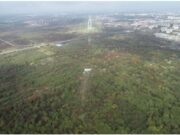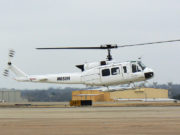
In what was described as a “really encouraging trend,” the rate of near–controlled flight into terrain (CFIT) occurrences in business aviation operations declined sharply in 2017 from the average of the three previous years, according to a presentation at Flight Safety Foundation’s 63rd annual Business Aviation Safety Summit (BASS) in Chicago May 10–11.
In presenting a review of corporate flight operational quality assurance (C-FOQA) data for 2017 from C-FOQA Centerline, Shelby Balogh, a data and analytics scientist at GE Aviation, also noted that the rate of aircraft upset/flight exceedances was down last year against the three-year average, but that the rate still is “significantly higher” than the near-CFIT rate. For 2017, the C-FOQA data cover 75,000 flights and about 150,000 flight hours by more than 30 aircraft types.
According to Balogh, the rate of near-CFIT events declined from the three-year average of 23.2 per 10,000 flights to 14.1 in 2017. The data show that 60 percent of the events occurred in visual meteorological conditions (VMC) and 20 percent in instrument meteorological conditions. The majority of the events — 59 percent — occurred during nighttime and 41 percent occurred during the day, he said.
Aircraft upset/flight envelope exceedance events declined to 45.3 per 10,000 flights in 2017 from the three-year average of just under 54.6 per 10,000 flights. Balogh said that 70 percent of the events involved angle of attack or attitude, including high angle of attack/low energy state events. Included in this data are attitudes of at least 25 degrees nose up or 10 degrees nose down. The other 30 percent of the events involved aircraft bank angles of 45 degrees or more.
 The rate of traffic-alert and collision avoidance system (TCAS) resolution advisories (RAs) declined in 2017 to approximately 9.87 per 1,000 flights from the three-year average of 10.74 per 1,000 flights. The data show that 80 percent of the TCAS RAs occurred below 10,000 ft and 50 percent occurred when the aircraft was within 20 nm (37 km) of its destination runway. Balogh’s presentation included a map of the United Sates showing areas of clusters of TCAS RAs. Some of the densest clusters appeared along the East Coast, which makes sense given that Teterboro (New Jersey) Airport is the nation’s busiest business aviation airport; along the West Coast in California; on the east coast of Florida; around Chicago; and in Texas.
The rate of traffic-alert and collision avoidance system (TCAS) resolution advisories (RAs) declined in 2017 to approximately 9.87 per 1,000 flights from the three-year average of 10.74 per 1,000 flights. The data show that 80 percent of the TCAS RAs occurred below 10,000 ft and 50 percent occurred when the aircraft was within 20 nm (37 km) of its destination runway. Balogh’s presentation included a map of the United Sates showing areas of clusters of TCAS RAs. Some of the densest clusters appeared along the East Coast, which makes sense given that Teterboro (New Jersey) Airport is the nation’s busiest business aviation airport; along the West Coast in California; on the east coast of Florida; around Chicago; and in Texas.
About 12.5 percent of the TCAS RAs involved an exceedance of the TCAS separation limits in situations in which one aircraft is climbing and approaching a level-off altitude and the other is transiting the same area. Balogh said these TCAS RAs could be eliminated if the pilots of the climbing aircraft reduced vertical speed as they approached the level-off altitude.
The rate of unstable approaches last year declined to 3.13 per 100 flights from the three-year average of 3.24 per 100 flights. Balogh said the top contributing factors to unstable approaches in 2017 were high rate of descent, excessive glidescope deviation, low power on approach and late landing gear extension. He also said the unstable approach rate was two times higher on visual approaches than on instrument landing system or area navigation approaches.
Balogh also discussed the importance of recognizing an unstable condition early/at a higher altitude. Looking at aircraft that continued to land, the data show that aircraft that 83 percent stable at 1,500 ft height above threshold (HAT) were 100 percent stable at 300 ft, while aircraft that were 65 percent stable at 1,500 ft were 89 percent stable by 300 ft HAT.
Just under 98.3 percent of unstable approaches end in a landing, according to the data, although the go-around rate increases to 3 percent in instrument meteorological conditions, Balogh said.
Of unstable approach aircraft that continued to landing, the most common stability factor not met prior to landing was energy state — meaning that the aircraft was either too fast and/or too high, or too slow and/or too low, Balogh said. About 56 percent of unstable approaches fell into this category. In 25 percent of cases, runway alignment, either glideslope or runway centerline, was the last unstable factor, and in 19 percent the issue was configuration, such as flaps set, gear down, spoilers armed.
Not all go-arounds are linked to unstable approaches, he said. “Most flights are quite stable when a go-around decision is made,” Balogh said, noting that at a median height of 400 ft above the runway threshold, aircraft that went around were, on average, 91 percent stable<?>. A decision to go around can be made for reasons other than approach stability, such as if ordered by air traffic control.
For flights that do go around from an unstable approach, the most common unstable approach factors present at the start of the go-around maneuver were a fast approach, low power and final flaps not set.
Of course, the go-around maneuver itself presents some risk. C-FOQA also has data on safety events that occur once the go-around has been initiated. The most common event is a flap overspeed, followed by a bank angle of greater than 45 degrees and a TCAS RA, according to Balogh.
Unstable landings occur at a rate of about 0.2 events for 100 flights overall, but the unstable landing rate is eight times higher on flights in which an approach that was unstable below 300 ft was continued to a landing.
Featured image: © SFIO CRACHO | Adobe Stock
Downward trend:© Asmati | VectorStock


